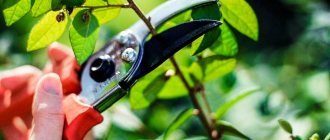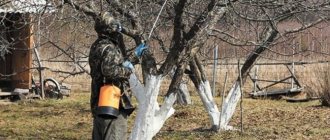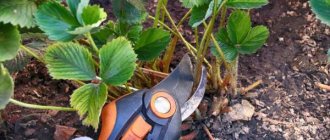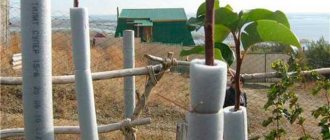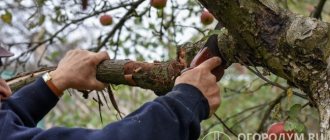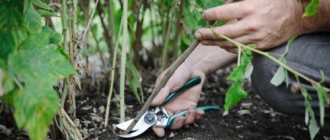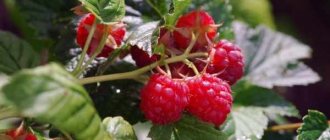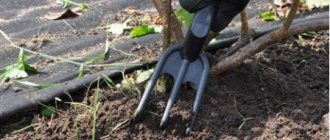A novice gardener should know when to prune trees and be able to cut branches correctly. Pruning helps the crown formation process, thereby eliminating unnecessary growth of branches in width and length. Also, cutting down is an effective way to make the harvest in the garden richer, protect against pests and significantly extend the life of the plant.
When can you prune fruit trees and why should you do it? These are popular questions among gardeners. Everyone wants to have a good harvest and healthy trees.
Pruning an apple tree in autumn
The following types of pruning are popular:
- Immediately after planting for faster root establishment in the planted soil.
- Shortening. It must be used for uncontrolled growth of branches in different directions and for crown formation.
- Health-improving. Dried, diseased or deformed branches are removed.
- Supportive. Excessively large branches are shortened, which gives the tree additional air flow.
The effect of pruning on the life of a tree
Pruning is considered stressful for the tree. However, using this procedure, you can regulate the issues of fruiting and the general condition of the plant.
Important! If you remove branches that grow incorrectly and give the crown excessive lushness, but do not shorten annual growth, you can speed up the time when the tree begins to bear fruit. However, the disadvantage in this matter will be that the crown will become spindly and unstable, the branches will become weak and have little life.
The most common mistake is shortening the branches too much. This way you can greatly expand the crown and slow down the growth of the crop, reducing the number of fruits. It is also not worth mindlessly pruning the plant - this will make it unstable to severe frosts.
In order to have large fruits and a beautifully folded crown, it is worth intensively pruning the annual growth every year. The fruits will be large, but the yield itself will be somewhat reduced due to the abundant branches.
Sealing of cut areas
Large wounds after pruning must be treated with sealing compounds. This will significantly shorten the healing time of wounds. If the pruning of the apple tree is done correctly, along the ring bead, then when sealing the cut areas, it is advisable to capture only the wood, without the bark. If more is cut out than required, then the bark must also be sealed. Stumps cannot be left when pruning, so sealing the stumps is out of the question at all.
To treat wounds, they use oil paint, antiseptic varnishes, mullein with clay, special compositions with copper sulfate, for example, “Rannet”, garden varnish. The most common preparation for self-use is garden varnish. The most effective professional is a two-component antiseptic varnish.
Rules for forming and trimming the crown
How to deal with aphids on fruit trees
When pruning and shaping the crown of trees, it is necessary to take into account that fruit crops have five stages of life:
- Growth of vegetative parts,
- Active growth and fruiting,
- Balanced growth with fruiting,
- Reduced growth and yield,
- Aging.
Note! When pruning the branches of a fruit tree, you should definitely take into account its age, stage of life and choose the appropriate pruning method.
Types of crowns that are obtained after pruning:
- Sparsely tiered. Suitable for most fruit trees.
- Whorled-tiered. Makes the tree too tall, making it difficult to harvest by hand.
- Tierless. Suitable for highly branched plants.
- Combined. Popular among cherries, pears and apple trees.
- Spindlebush (spindle-shaped). Suitable for low-growing trees.
- Bush-like. For vigorous species.
- Semi-flat: for plums, cherry plums, apricots.
- Palmettes, cordons (flat). Suitable if you want to increase productivity.
Safety precautions
Safety precautions concern pruning processes and garden equipment issues:
- Sharp, heavy objects should not be thrown, only passed from hand to hand. Each of them must have its own case during transportation.
- When carrying out the procedure, use gloves to prevent damage and splinters.
- Keep children away from tools that are dangerous for them.
- Sharpen secateurs and knives in a timely manner. Hooks on which you can hang items are suitable for storage.
- When pruning, use a stepladder or ladder with wide steps. Do not prune in the rain or on wet stairs.
- Wear comfortable shoes to avoid slipping.
Tree pruning and crowning
Pruning large branches on old trees
The wood of older trees is usually very dense, so improper pruning can damage the bark.
The cut should be made on the underside, one-third deep. About 3 cm is retreated from the lower cut, then the branch from above is cut down. In this case, the bark will definitely remain intact and unharmed and will not be able to come off.
Trimming and cutting technology
The branches are shortened by removing this part from the total length:
- One third of the pruning is a slight shortening,
- Half is average
- More than half are strong.
Rejuvenating fruit tree pruning
Technologies:
- “Under the ring” - the cut is made on the top of the bead on the wood.
- Pruning entire branches - to get rid of excess branching, in order to penetrate the sunny color to the inside of the crown.
- Kerbovka. A rare event that is carried out to slow down growth processes.
Note! Some time before the end of the growing season, the growth buds are pinched, after which the formation of ringlets and strong lateral branches begins.
Crown formation scheme
There are quite a lot of schemes for the formation of tree crowns. The most popular are:
- Tiered-pruned. Creates a strong plant skeleton.
- Cupped. Perfectly suits apple trees, creating a solid foundation.
- Fusiform. Requires annual manual labor.
In annual apple trees, crown formation occurs after planting. The seedlings do not have strong branches, so during the first pruning it is important to achieve a good result so that the active growth of new shoots begins.
Is there a need to cut and process the apple tree?
In order for fruit trees to produce a harvest every year, they need to form a branched part, removing excess branches, redirecting new shoots, removing dry and diseased parts. But at the same time, damage remains on the trunk that should be treated.
This procedure is necessary to seal the wound and is an obstacle to the penetration of infections and bacteria. The fact is that negative processes begin to occur in an unprotected area.
First of all, an untreated cut causes the branch to dry out. This happens because the movement of organic substances is disrupted and nutrients do not reach the part of the shoot that is located above the cut, and moisture evaporates through the recess itself
In addition, cracking may begin in an unprotected area. Moreover, the cracks can be quite deep. Sometimes hollows may appear in the area where the saw cut has damaged the wood.
It is timely and competent processing that is the main prevention of the formation of depressions, rotting of wood and damage to it by fungal diseases.
Timing of pruning
What kind of trees are there in the middle zone - deciduous and coniferous trees
The timing of pruning is best coordinated with the lunar calendar and sidereal cycles. So, on a waning moon, sap flow increases, then when the Earth passes the zodiac signs of Pisces, Aquarius and Cancer, it drops significantly.
Additional Information. The pruning season always depends on the type, age of the fruit tree, where the garden is located, and in what climatic conditions the plants are located.
In the Moscow region, the timing varies: here you can use not only spring pruning, but also do it in summer (May, June) and winter (February). In Siberia, trees are pruned only in early spring, in March, then the fruits will be very large and juicy.
Important! In no case should pruning be done with a rusty tool, or branches should be torn off by hand - the plant will get sick and die. It is also necessary to process large sections and cover them with oil paint or varnish. Apricots or peaches even have small sections. In this case, the wound healing rate will increase to 3 cm per year (without treatment - 1 cm per year).
Favorable days in 2022 for pruning in the fall:
- September: 1, 16, 26, 28.
- October: 5, 8, 13, 29.
- November: 4, 9, 25, 28.
December is considered a month of rest for gardeners.
Water-based paint
Such a coating will not be able to solve serious problems, but it will easily help heal minor wounds and damage to the bark. With this paint you can immediately “whiten” trees in preparation for winter.
Unlike oil paint, water-based paint does not impede air circulation, so mold does not form on the wood underneath it. True, this “tree support” will have to be renewed every season, because water-based paint is extremely not resistant to weather conditions.
Pruning in autumn
Fruit trees and shrubs for the garden, columnar fruit trees
In the autumn, pruning is carried out:
- old branches,
- Rotten, broken and damaged branches.
Pruning scheme to form a controlled growing crown
In autumn, the tree enters a dormant phase, so the procedure will not bring significant stress to it. The event plan is as follows:
- Large, broken branches are cut off,
- Among the closely growing branches, the weakest ones are cut out,
- Branches that grow with sharp corners are trimmed
- It is worth covering up the cuts: on young ones - after a day, on dry ones - immediately,
- The cut branches are burned.
Best time to prune
When is the best time to prune trees, fall or spring, depends on many factors. It is preferable to do this in the spring, since during these months the tree is just waking up, and the wounds will heal faster.
Important! Pear, cherry, and plum trees may become diseased after pruning in the fall. Also, you should not prune young seedlings at this time.
If broken branches suddenly appear after bad weather, they should be removed immediately, regardless of the time of year. One contraindication for this may be an air temperature of -5 degrees or lower.
If sap flows after cutting branches
If sap is oozing from small cuts that you did not cover, the pruning was done very late and the wounds simply did not heal before the sap began to flow. This is not harmful for the tree, but small branches and hearth buds may dry out. You can partially protect the tree by making a clay liquid mash and applying it to all wounds, including the smallest ones. If juice flows from several large cuts, it means that you have not sealed, foamed, or painted the damage. Clean the surface with improvised means and do everything again. Carry out caulking work efficiently - otherwise there will be no use from it.
To better secure the putty on the branch, use a bandage to wrap it around the damaged area.
How to cover up saw cuts
Cuts and wounds usually need to be sealed with a sealant. This prevents water and germs from entering the cracks. If this is not done, the branch will begin to dry out on the cut, juice will be released, and water will begin to evaporate. Subsequently, a cavity may appear in the cut area.
How to cover saw cuts on fruit trees:
- Garden resin,
- A mixture of loam,
- If the wound is excessively large, then a cement solution is used,
- Water-based paint,
- Artificial turf,
- Garden var.
Garden var from
You can make putties yourself or purchase them in specialized stores.
Adviсe
What to do if sap flows after cutting a branch
The appearance of juice from small saw cuts indicates the beginning of sap flow. The pruning was done late. The wounds did not have time to heal. Liquid clay mash is used to lubricate all damage. Juice from large cuts indicates a leak in the putty. You should:
- clean the surface again;
- cover with thick clay mash;
- secure on top with cotton cloth.
If a cut on a branch turns black
Blackening (darkening) indicates infection with apple canker and cytosporosis. The causative agents of these diseases appear on saw cuts that were not treated in time. The disease spreads to neighboring branches and can destroy the entire garden. The treatment goes like this:
- cut off the infected wood, covering adjacent healthy areas;
- treated with 3% Bordeaux mixture or 1%, it depends on the end of the growing season or development;
- After drying, cover with garden varnish or mash.
The entire tree is treated, not just the wounds.
What to do if the apple tree cut rots
Rotting is caused by spores of the tinder fungus.
The open cut collects germs and bacteria and serves as a place for infection. The fight against the disease comes down to removing the infected parts. There are no special means. The branch is cut off. Light wood on the cut indicates that the disease has not spread to the entire tree. The branch is burned, the cut is treated with a disinfectant and garden varnish.
If the tree is dark, the apple tree dies. It is cut down and burned.
Garden varnish at home
Before preparing a solution of garden varnish at home, you should prepare fat, rosin and wax.
Additional Information. Each ingredient has an important function. Fat will help the composition not to dry out in the heat, rosin is a good binder with the plant, wax prevents the penetration of moisture.
Fat options can be drying oil or vegetable oil. Instead of wax, you can use turpentine.
Var for trees:
- Fat and rosin – 1 part, wax – 2 parts. First, all the constituent elements must be melted, and after mixing, pour cold water.
- Drying oil (1 part) – Rosin (4) – Paraffin (20).
- Vegetable oil (1 part) and 2 parts each of wax and rosin.
If desired, you can add ash to the varnish.
Bark scuffing when cutting thick branches
When cutting branches, not all novice gardeners think of cutting from below first, and as a result, the bark is scuffed , after which the wound is difficult to heal.
It is better to remove large branches in parts: first, you need to cut the branch as deeply as possible (until the file jams) from below (1) at a distance of 30-40 cm from its base, and then, stepping back 5-10 cm further, make a second cut from above ( 2). The branch will break off due to its own gravity, but the bark will not tear. After this, it is not difficult to cut down the remaining stump (also with the bottom cut) (3).
Using garden varnish during processing
Before covering the cuts and wounds of the plant, the varnish for garden trees should be melted. When it has softened, applying a thin layer of it to the cut is not difficult. A thick layer can cause branches to rot.
Note! During the procedure, make sure that the varnish does not get on the bark. Only the cut itself can be processed. The bark should remain clean, then the process of forming a bark ridge, which helps the wound heal, will be faster and more natural.
When cuts are formed: if you cut down old dead wood, damaged branches
The main reasons for the formation of slices:
- Crown formation - in order for apple trees to bear fruit and grow well, they need to be formed correctly, but after pruning, defects often appear on the bark and branches.
- Removing old branches - when cutting branches from trunks, wounds almost always form that need to be properly disinfected and treated with special protective agents. Read about how to prune an apple tree in the spring at this link.
- Rejuvenation is the same pruning, but for older trees. Any traumatic events (and during rejuvenation the volume of removal of branches and shoots is significant) can cause the appearance of cuts.
Pruning trees and covering wounds with a special product is not carried out on the same day. Wait a few days until the cut dries and proceed to covering.
Furrowing fruit trees
Furrowing the bark of trees prevents the appearance of dangerous cracks that contribute to the separation of the bark from the wood. After furrowing, the trunk begins to actively grow in thickness, the activity of the cambium intensifies, and a young elastic bark is formed. The danger of frost damage is also reduced.
Apple tree bark cracking
Manipulation is performed using a special furrower-knife on a handle with a blade depth of 1.5-2 mm.
Furrowing is carried out using two methods:
- The cuts are made 10 cm apart at a distance of 1-2 cm from each other from the crown itself to the root collar.
- Continuous long cuts are made.
The incisions are immediately disinfected with a solution of 2% copper sulfate. Usually the event is first carried out 3-4 years after planting.
If you prune the tree correctly, seal it and process the wood in the right places, then the fruit harvest will not take long to arrive. A beautiful apple or pear tree will be strong and strong and will take on an elegant, well-groomed appearance. It is very important to do the procedure for the first time according to recommendations or under the supervision of knowledgeable and experienced gardeners, so as not to cut down important branches of the tree and lead to the death of the plant.
Oil paint
Painting a cut on an apple tree after cleaning and disinfecting it with oil paint is cheap and easy. It contains substances that prevent the growth of fungus and bacteria; it adheres tightly to damaged wood and forms a thin protective film.
Paint based on natural oils is best, but in a pinch, regular paint based on natural drying oil will do. The cut of the apple tree must be coated with paint using a brush for 2-3 layers, avoiding contact with undamaged areas of the bark. The coating may crumble due to rain and frost, then the procedure will need to be repeated.

